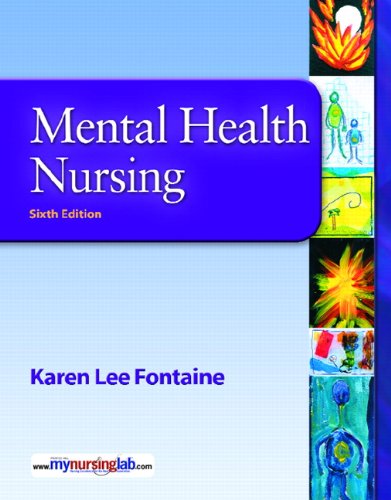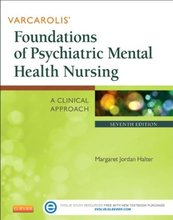This is completed downloadable of Mental Health Nursing, 6 Ed Test Bank

Product Details:
- ISBN-10 : 0135146550
- ISBN-13 : 978-0135146552
- Author:
Written in a student-friendly style, this comprehensive text, and leading resource in the field of mental health nursing, emphasizes effective communication skills, details cultural considerations, and presents mental health disorders within a systematic organizational framework using the nursing process. It reflects the diversity of its student readers, and the belief that the practice of mental health nursing is in direct response to the social, cultural, environmental, and biological components of mental illness.
Table of Content:
- UNIT ONE: Foundations for Mental Health Nursing
- UNIT TWO: Threats to Mental Health
- UNIT THREE: Special Populations
- UNIT ONE Foundations for Mental Health Nursing
- CHAPTER 1 History of Mental Health Nursing
- THE TRAILBLAZERS
- Florence Nightingale
- Dorothea Dix
- Linda Richards
- Harriet Bailey
- Effie Jane Taylor
- Mary Mahoney
- Hildegard Peplau
- Hattie Bessent
- Bessie Blount Grifn
- THE FACILITIES
- Asylums
- Hospitals
- Free-Standing Facilities
- THE BREAKTHROUGHS
- Nurse Training
- Psychotropic Medications
- Deinstitutionalization
- Organizations for Mental Health Nurses and Others
- THE LAW
- Hill-Burton Act
- National Mental Health Act of 1946
- Community Mental Health Centers Act of 1963
- Patient Bill of Rights
- Afordable Care Act
- Key Points
- Review Questions
- CHAPTER 2 Basics of Communication
- COMMUNICATION THEORY
- Sender, Receiver, and Interpretation of Message
- TYPES OF COMMUNICATION
- Verbal and Written Communication
- Nonverbal Communication
- Aggressive Communication VersusAssertive Communication
- Aggressive Communication
- Assertive Communication
- Social Communication
- Therapeutic Communication
- Neurolinguistic Programming
- CHALLENGES TOCOMMUNICATION
- People Who Have Hearing Impairments
- People Who Have Visual Impairments
- People Who Have Laryngectomies
- People With Language Differences
- People Who Have Aphasic/Dysphasic Disorders
- THERAPEUTIC COMMUNICATION
- Nontherapeutic Communication
- Techniques of Therapeutic/Helping Communication
- ADAPTIVE COMMUNICATIONTECHNIQUES
- People Who Have Hearing Impairments
- People Who Have Visual Impairments
- People Who Have Laryngectomies
- People With Language Differences
- People Who Have Aphasic/Dysphasic Disorders
- Key Points
- Review Questions
- CHAPTER 3 Ethics, Evidence-Based Practice, and Regulations
- PROFESSIONALISM
- ETHICS
- EVIDENCE-BASED PRACTICE
- Standards of Care
- Nurse Practice Act
- Accurate Documentation
- Culture of Nurses
- CONFIDENTIALITY
- Health Insurance Portability and Accountability Act
- The Joint Commission
- RESPONSIBILITY
- ACCOUNTABILITY
- Impaired Nurses
- ABIDING BY THE CURRENT REGULATIONS
- Good Samaritan Laws
- Involuntary Commitment
- Voluntary Commitment
- Restraint Usage
- PATIENTS’ RIGHTS
- PATIENT ADVOCACY
- COMMUNITY RESOURCES
- Key Points
- Review Questions
- CHAPTER 4 Developmental Psychology Throughout the Life Span
- HUMAN DEVELOPMENT
- DE VELOPMENTAL THEORISTS: NEWBORN TO ADOLESCENCE
- Sigmund Freud (1856–1939)
- Erik Erikson (1902–1994)
- Jean Piaget (1896–1980)
- Lawrence Kohlberg (1927–1987)
- DEVELOPMENTAL THEORISTS:ADOLESCENCE TO ADULTHOOD
- Sigmund Freud (1856–1939)
- Karen Horney (1885–1952)
- Ivan Pavlov (1849–1936) and B. F.Skinner (1904–1990)
- Abraham Maslow (1908–1970)
- Physiological Needs
- Safety and Security
- Love and Belonging
- Self-Esteem
- Self-Actualization
- Carol Gilligan (1936– )
- Carl Rogers (1902–1987)
- Carl Jung (1875–1961)
- STAGES OF HUMANDEVELOPMENT
- Death and Dying
- Elisabeth Kübler-Ross (1926–2004)
- Key Points
- Review Questions
- CHAPTER 5 Sociocultural Influences on Mental Health
- THE SOCIOCULTURAL THEORY OF DEVELOPMENT
- CULTURE
- RELIGION
- SPIRITUALITY
- ETHNICITY
- THE CHANGING FAMILY
- HOMELESSNESS
- ECONOMIC CONSIDERATIONS
- ABUSE
- PARENTING
- Key Points
- Review Questions
- CHAPTER 6 Nursing Process in Mental Health
- NURSING PROCESS
- STEP 1: ASSESSING THE PATIENT’S MENTAL HEALTH
- Guidelines for Nurse-Patient Helping Interview
- STEP 2: NURSING DIAGNOSIS: DEFINING PATIENT PROBLEMS
- STEP 3: PLANNING (SHORT- AND LONG-TERM GOALS)
- STEP 4: IMPLEMENTATIONS/ INTERVENTIONS
- Patient Teaching
- Principles of Learning
- Principles of Teaching
- Additional Patient Teaching Tips
- STEP 5: EVALUATION/OUTCOME
- Key Points
- Review Questions
- CHAPTER 7 Stress, Coping, and Defense Mechanisms
- COPING
- DEFENSE MECHANISMS
- Key Points
- Review Questions
- CHAPTER 8 Medications and Other Therapies
- PSYCHOPHARMACOLOGY
- Antipsychotics (Neuroleptics, Major Tranquilizers)
- Antiparkinson Agents (Anticholinergics)
- Antianxiety Agents (Anxiolytics/ Minor Tranquilizers)
- Antidepressants (Mood Elevators)
- Selective Serotonin Reuptake Inhibitor (SSRI)
- Tricyclic Antidepressants
- Tetracyclic Antidepressants (Heterocyclic Antidepressants)
- Serotonin Norepinephrine Reuptake Inhibitors (SNRIs)
- Monoamine Oxidase Inhibitors (MAOIs)
- Alternative Treatments for Depression
- Antimanic Agents (Mood Stabilizing Agents)
- Lithium Carbonate
- Anticonvulsants
- Stimulants
- MILIEU
- PSYCHOTHERAPIES
- Psychoanalysis
- Free Association
- Dream Analysis
- Hypnosis
- Catharsis
- Behavior Modifcation
- Cognitive Therapies
- Rational-Emotive Behavioral Therapy (REBT)
- Person-Centered/Humanistic Therapy
- Unconditional Positive Regard
- Counseling versus Psychotherapy
- Pastoral or Cultural Counseling
- Group Therapy
- Other Types of Therapy
- Electroconvulsive Therapy
- Nursing Responsibilities
- Humor Therapy
- Animal-Assisted Therapy
- Crisis Intervention
- Goals of Crisis Intervention
- Nursing Responsibilities
- Legal Considerations in Crisis Intervention
- SUMMARY
- Key Points
- Review Questions
- CHAPTER 9 Complementary and Alternative Treatment Modalities
- THE MIND-BODY CONNECTION AND MINDFULNESS
- COMMON COMPLEMENTARY AND ALTERNATIVE TREATMENTS
- Biofeedback
- Aromatherapy
- Herbal and Dietary Supplements
- Traditional Chinese Medicine
- Ayurveda
- Massage, Energy, and Touch
- Yoga
- Hypnotherapy
- Neurolinguistic Programming
- PRIMARY SENSORY REPRESENTATION
- SUMMARY
- Key Points
- Review Questions
- UNIT TWO Threats to Mental Health
- CHAPTER 10 Anxiety, Somatic Symptom Disorders, and Post-Traumatic Stress Disorder
- ANXIETY DISORDERS
- ETIOLOGY AND SYMPTOMSOF ANXIETY
- DIFFERENTIAL DIAGNOSES
- Diagnostic Studies
- Treatments
- TYPES OF ANXIETY ANDANXIETY-RELATED DISORDERS
- Generalized Anxiety Disorder (GAD)
- Panic Disorder
- Specific Phobia
- MEDICAL TREATMENT OF PEOPLEWITH ANXIETY AND ANXIETYRELATEDDISORDERS
- ALTERNATIVE INTERVENTIONSFOR PEOPLE WITH ANXIETY ANDANXIETY-RELATED DISORDERS
- Aromatherapy
- Biofeedback
- Hypnotherapy
- Additional Alternative Interventions
- NURSING CARE FOR PEOPLE WITH ANXIETY AND ANXIETY RELATED DISORDERS
- General Interventions
- SOMATIC SYMPTOM ANDRELATED DISORDERS
- Somatic Symptom Disorder (SSD)
- Etiology of Somatic SymptomDisorder
- Differential Diagnoses
- Somatic Symptom Related Disorders
- Medical Treatment of Patients With Somatic Symptom and Related Disorders
- Alternative Interventions for Patients With Somatic Symptom and RelatedDisorders
- Nursing Care of the Patient With Somatic Symptom and Related Disorders
- Post-Traumatic Stress Disorder
- DIFFERENTIAL DIAGNOSES
- Psychotherapeutic Treatments (APA,Clinical, 2017)
- Complementary and AlternativeTherapies for PTSD
- Diagnostic Test
- Nursing Interventions
- CHAPTER 11 Depressive Disorders
- TYPES OF DEPRESSIVE DISORDERS
- Major Depressive Disorder
- Prolonged Grief Disorder
- Persistent Depressive Disorder
- Postpartum Depression
- Substance/Medication-Induced Depressive Disorder
- Depressive Disorder Due to Another Medical Condition
- Premenstrual Dysphoric Disorder
- Depressive Disorder With Seasonal Pattern
- DIFFERENTIAL DIAGNOSES FOR DEPRESSIVE DISORDERS
- ETIOLOGY OF DEPRESSIVE DISORDERS
- TREATMENT OF DEPRESSIVE DISORDERS
- Alternative Treatments
- Light Therapy
- Herbal and Nutritional Therapy
- NURSING CARE OF THE PATIENT WITH DEPRESSIVE DISORDERS
- General Nursing Interventions
- CONCEPT MAP
- Key Points
- Review Questions
- CHAPTER 12 Bipolar Disorders
- CHARACTERISTICS OF BIPOLAR DISORDERS
- Manic Phase
- Depressed Phase
- ETIOLOGY OF BIPOLAR DISORDERS
- Differential Diagnoses
- TREATMENT OF BIPOLAR DISORDERS
- NURSING CARE OF THE PATIENT WITH BIPOLAR DISORDERS
- General Nursing Interventions
- Key Points
- Review Questions
- CHAPTER 13 Suicide
- THE REALITY OF SUICIDE
- ETIOLOGY OF SUICIDE
- The Warning Signs of Suicide
- Differential Diagnosis
- TREATMENT OF INDIVIDUALS AT RISK FOR SUICIDE
- NURSING CARE OF THE SUICIDAL PATIENT
- General Nursing Interventions
- Key Points
- Review Questions
- CHAPTER 14 Personality Disorders
- TYPES OF PERSONALITY DISORDERS
- Cluster A
- Paranoid Personality Disorder
- Schizoid Personality Disorder
- Schizotypal Personality Disorder
- Cluster B
- Antisocial Personality Disorder
- Borderline Personality Disorder
- Histrionic Personality Disorder
- Narcissistic Personality Disorder
- Cluster C
- Avoidant Personality Disorder
- Dependent Personality Disorder
- Obsessive-Compulsive Personality Disorder
- PSYCHIATRIC TREATMENT OF PERSONALITY DISORDERS
- NURSING CARE OF PATIENTS WITH PERSONALITY DISORDERS
- General Nursing Interventions for Personality Disorders
- Key Points
- Review Questions
- CHAPTER 16 Neurocognitive Disorders: Delirium and Dementia
- DELIRIUM
- Treatment of Delirium
- DEMENTIA
- Alzheimer’s Disease
- Other Forms of Dementia
- Differential Diagnosis of Delirium and Dementia
- DIFFERENTIAL DIAGNOSES FOR DEMENTIA
- Treatment of Dementias
- NURSING CARE OF PATIENTS WITH DELIRIUM AND DEMENTIA
- General Nursing Interventions
- Key Points
- Review Questions
- CHAPTER 17 Substance Use and Addictive Disorders
- ALCOHOL
- Effect on the Family
- Alcohol’s Impact on Health
- Etiology of Alcohol Abuse
- Alcohol Withdrawal
- Treatment of Alcohol Use Disorder
- OTHER SUBSTANCES
- Etiology of Substance Use Disorders
- Treatment of Substance Use Disorders
- NURSING CARE OF PATIENTS WITH SUBSTANCE USE DISORDERS (INCLUDING ALCOHOL)
- General Nursing Interventions
- Key Points
- Review Questions
- CHAPTER 18 Eating Disorders
- ANOREXIA NERVOSA
- SYMPTOMS OF ANOREXIA NERVOSA
- Etiology of Anorexia Nervosa
- TREATMENT OF ANOREXIA NERVOSA
- BULIMIA
- Symptoms of Bulimia
- Etiology of Bulimia
- Treatment of Bulimia
- BINGE EATING DISORDER
- MORBID OBESITY
- Etiology of Morbid Obesity
- Treatment of Morbid Obesity
- NURSING CARE OF PATIENTS WITH EATING DISORDERS
- General Nursing Interventions for Patients With Eating Disorders
- Review Questions
- Key Points
- UNIT THREE Special Populations
- CHAPTER 19 Childhood and Adolescent Mental Health Issues
- DEPRESSION, BIPOLAR DISORDER, AND SUICIDE IN CHILDREN AND ADOLESCENTS
- Depression
- Bipolar Disorder
- Suicide
- Treatment of Children and Adolescents With Depression, Bipolar Disorder, and Suicidal Behavior
- Nursing Care of Children and Adolescents With Depression, Bipolar Disorder, and Suicidal Behavior
- General Nursing Interventions
- ATTENTION DEFICIT- HYPERACTIVITY DISORDER
- Treatment of Children and Adolescents With ADHD
- Nursing Care of Children and Adolescents with ADHD
- General Nursing Interventions
- AUTISM SPECTRUM DISORDER
- Treatment of Children and Adolescents with ASD
- Nursing Care of Children and Adolescents With ASD
- General Nursing Interventions
- CONDUCT DISORDER
- Treatment of Children and Adolescents With Conduct Disorder
- Nursing Care of Children and Adolescents With Conduct Disorder
- General Nursing Interventions
- Key Points
- Review Questions
- CHAPTER 20 Postpartum Issues in Mental Health
- POSTPARTUM BLUES
- Treatment of Postpartum Blues
- POSTPARTUM DEPRESSION
- Treatment of Postpartum Depression
- POSTPARTUM PSYCHOSIS
- Treatment of Postpartum Psychosis
- NURSING CARE OF WOMEN WITH POSTPARTUM MENTAL DISORDERS
- General Nursing Interventions
- Key Points
- Review Questions
- CHAPTER 21 Aging Population
- ALZHEIMER’S DISEASE AND OTHER COGNITIVE ALTERATIONS
- CEREBROVASCULAR ACCIDENT (STROKE)
- Depression Associated With CVA
- Aphasia
- DEPRESSION IN THE OLDER ADULT
- MEDICATION CONCERNS
- PARANOID THINKING
- INSOMNIA
- END-OF-LIFE ISSUES
- SOCIAL CONCERNS
- NURSING SKILLS FOR WORKING WITH OLDER ADULTS
- RESTORATIVE NURSING
- PALLIATIVE CARE
- Key Points
- Review Questions
- CHAPTER 22 Abuse and Violence
- THE ABUSER
- THE VICTIM
- CATEGORIES OF ABUSE
- Child Abuse
- Sexual Abuse
- Intimate Partner Violence
- Elder Abuse
- TREATMENT OF ABUSE
- NURSING CARE OF VICTIMS OF ABUSE
- General Nursing Interventions
- Key Points
- Review Questions
- APPENDIX A Answers and Rationales
- CHAPTER 1
- History of Mental Health Nursing
- CHAPTER 2
- Basics of Communication
- CHAPTER 3
- Ethics, Evidence-Based Practice, and Regulations
- CHAPTER 4
- Developmental Psychology Throughout the Life Span
- CHAPTER 5
- Sociocultural Influences on Mental Health
- CHAPTER 6
- Nursing Process in Mental Health
- CHAPTER 7
- Stress, Coping, and Defense Mechanisms
- CHAPTER 8
- Medications and Other Therapies
- CHAPTER 9
- Complementary and Alternative Treatment Modalities
- CHAPTER 10
- Anxiety, Somatic Symptom Disorders, and Post-Traumatic Stress Disorder
- CHAPTER 11
- Depressive Disorders
- CHAPTER 12
- Bipolar Disorders
- CHAPTER 13
- Suicide
- CHAPTER 14
- Personality Disorders
- CHAPTER 15
- Schizophrenia Spectrum and Other Psychotic Disorders
- CHAPTER 16
- Neurocognitive Disorders: Delirium and Dementia
- CHAPTER 17
- Substance Use and Addictive Disorders
- CHAPTER 18
- Eating Disorders
- CHAPTER 19
- Childhood and Adolescent Mental Health Issues
- CHAPTER 20
- Postpartum Issues in Mental Health
- CHAPTER 21
- Aging Population
- CHAPTER 22
- Abuse and Violence
- APPENDIX B Agencies That Help People Who Have Threats to Their Mental Health
- APPENDIX C Organizations That Support the Licensed Practical/Vocational Nurse
- APPENDIX D Standards of Nursing Practice for LPNs/LVNs
- NATIONAL ASSOCIATION OF LICENSED PRACTICAL NURSES (NALPN) CODE FOR LICENSED PRACTICAL/VOCATIONAL NUR
- NALPN NURSING PRACTICE STANDARDS
- Introductory Statement
- Standards
- Education
- Legal/Ethical Status
- Practice
- CONTINUING EDUCATION
- SPECIALIZED NURSING PRACTICE
- APPENDIX E Assigning Nursing Diagnoses to Client Behaviors
- Glossary
- Index





